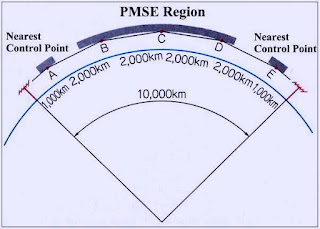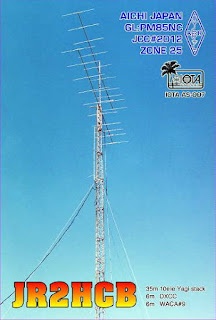Posts Tagged ‘6m’
 Having fun on the "Magic Band"
Having fun on the "Magic Band"
Still a relative newcomer to the hobby (only licensed at end of 2013) I had little experience of the 50MHz/6m band and have been mostly met with static whenever I did turn the dial to have a listen but happily that has changed in the last few weeks.
I knew that 6m can be an interesting, unpredictable almost unique band. Being at the lower end of the VHF spectrum it exhibits the usual characteristics of VHF communication, mostly short range line-of-sight contacts since 50MHz is usually well beyond the maximum usable frequency (MUF) for normal 'F-layer' ionospheric propagation utilised by the lower bands. However solar activity and other factors can trigger other types of propagation, in fact the band can support just about every form of propagation possible and is the main reason why it has become known as the "Magic Band"
One interesting form of propagation is sporadic E, or popularly referred to as Es. Small clouds of unusually ionised atmospheric gas form in the lower E-layer of the ionosphere (located at altitudes of 90 to 160 km). These clouds 'bounce' the radio waves allowing long-distance communication at VHF frequencies, sometimes multiple hops are possible giving extreme DX. One advantage of sporadic E over other forms of propagation is that it allows low-power QRP communication. As its name suggests, sporadic E is not a normal occurrence but can happen at almost any time. It does display a seasonal pattern with activity peaking in the summertime most noticeable in mid-to-late June.
I had turned the antenna to the East and have been running WSPR on and off over the last month on 6m with no luck, just the odd spot from the UK. I was in the shack one Saturday evening and was tuning around on 6m and heard some Italian stations calling CQ on SSB. I tried my luck and answered (using 50W) and was amazed to be heard, working a couple of stations in quick succession then suddenly the opening closed mid contact with another station. I was hooked!
Over the past few weeks I have caught a few more openings and have managed to work (in no particular order) Latvia, Croatia, Lithuania, Slovenia, Czech Republic, Slovakia, Serbia, Italy, Germany, Switzerland, Poland, France, Spain, Austria, Canary Islands and Finland - using a combination of voice on SSB and the JT65 digital mode.
Using JT65 has been particularly interesting since it allows me to 'remote operate' from work otherwise I would miss most of the 'Es'. Being able to monitor the waterfall and see the signals gaining and falling in strength during the minute long transmission is particularly fascinating.
Using the PSKReporter website I can see the location of all the stations I could hear and was being heard by. This map shows activity over the couple of hours on the 26 May using just JT65.
I have joined the UK Six Meter Group (UKSMG) to find out more about this "magic band" and their website is full of lots of information and resources along with the magazine Six News for subscribers.
 Having fun on the "Magic Band"
Having fun on the "Magic Band"
Still a relative newcomer to the hobby (only licensed at end of 2013) I had little experience of the 50MHz/6m band and have been mostly met with static whenever I did turn the dial to have a listen but happily that has changed in the last few weeks.
I knew that 6m can be an interesting, unpredictable almost unique band. Being at the lower end of the VHF spectrum it exhibits the usual characteristics of VHF communication, mostly short range line-of-sight contacts since 50MHz is usually well beyond the maximum usable frequency (MUF) for normal 'F-layer' ionospheric propagation utilised by the lower bands. However solar activity and other factors can trigger other types of propagation, in fact the band can support just about every form of propagation possible and is the main reason why it has become known as the "Magic Band"
One interesting form of propagation is sporadic E, or popularly referred to as Es. Small clouds of unusually ionised atmospheric gas form in the lower E-layer of the ionosphere (located at altitudes of 90 to 160 km). These clouds 'bounce' the radio waves allowing long-distance communication at VHF frequencies, sometimes multiple hops are possible giving extreme DX. One advantage of sporadic E over other forms of propagation is that it allows low-power QRP communication. As its name suggests, sporadic E is not a normal occurrence but can happen at almost any time. It does display a seasonal pattern with activity peaking in the summertime most noticeable in mid-to-late June.
I had turned the antenna to the East and have been running WSPR on and off over the last month on 6m with no luck, just the odd spot from the UK. I was in the shack one Saturday evening and was tuning around on 6m and heard some Italian stations calling CQ on SSB. I tried my luck and answered (using 50W) and was amazed to be heard, working a couple of stations in quick succession then suddenly the opening closed mid contact with another station. I was hooked!
Over the past few weeks I have caught a few more openings and have managed to work (in no particular order) Latvia, Croatia, Lithuania, Slovenia, Czech Republic, Slovakia, Serbia, Italy, Germany, Switzerland, Poland, France, Spain, Austria, Canary Islands and Finland - using a combination of voice on SSB and the JT65 digital mode.
Using JT65 has been particularly interesting since it allows me to 'remote operate' from work otherwise I would miss most of the 'Es'. Being able to monitor the waterfall and see the signals gaining and falling in strength during the minute long transmission is particularly fascinating.
Using the PSKReporter website I can see the location of all the stations I could hear and was being heard by. This map shows activity over the couple of hours on the 26 May using just JT65.
I have joined the UK Six Meter Group (UKSMG) to find out more about this "magic band" and their website is full of lots of information and resources along with the magazine Six News for subscribers.
 6m/70cm antenna updates at the QTH
6m/70cm antenna updates at the QTH
The 70cm yagi was to replace the small 7-element one which I pressed into service as a hand held antenna for potentially finding my HAB payloads last year.
To be honest I wasn't really after a 6m antenna due to the size and visual impact. I have a 6m 'wooden' moxon I made back in 2014 but it is heavy, ugly and unstable so had been collecting cobwebs in the garage. I decided with the prospect of 'Sporadic E' season around the corner I would be foolish not to put it up.
The HB9CV wasn't in the best of conditions but seemed complete albeit it was purchased dismantled. The elements were a little weathered so I set about cleaning them up with a light rubbing down with some wire wool and a rag with a drop of WD40. On closer inspection the tube that made up the front element had some noticeable bending and on removing the plastic mounting to investigate I spotted a crack in the tube wall by the hole for the mounting bolt.
While it hadn't totally separated it would only be a matter of time before it did fail as it was flexing, the plastic mount was the only thing holding it together. I found a suitable piece of alloy tube from a scrap antenna which was a perfect fit inside the broken element. I cut a suitable length and pushed it up inside the element to the appropriate position and then simply drilled through and bolted either side of the central hole to stabilise and strengthen it (can be seen in image below)
The next issue I had to address was the feed point, it came with about six inches of RG58 coax projecting from it where it had simply been cut for removal by the previous owner. I prised off the cover cap to find it full of water, the reason being a hole in the back and it being stored outside I believe.
Thankfully the trimming capacitor seemed okay, while it was wet it wasn't corroded. It was all dried out and the hole plugged with silicon and I set about re-assembling the antenna which was a little fiddly to get the phasing line to sit properly but once done it was a simple matter of adjusting the capacitor to get the VSWR to a minimum in the SSB section of the 6m band. I mounted on the rotator pole just below the X50 collinear.
I used it last month in the 6m UKAC and while my operating not exactly earth shattering I was happy with its performance using just 10W in the low power section just "search and pouncing" for a little over an hour.
.
The 70cm Yagi was straight forward as was already assembled, I just had to make a slight tweak to the gamma-matching bar as the VSWR was unexpectedly high around 2:1 in the SSB segment of the band, it seemed to have been tuned for the FM portion of the band. I managed just an hour "search and pouncing" in Aprils 70cm UKAC, I started late and while signal reports both ways were a marked improvement I found the extra directionality and off beam rejection something I will have to get used not helped by a temperamental rotator.
 6m/70cm antenna updates at the QTH
6m/70cm antenna updates at the QTH
The 70cm yagi was to replace the small 7-element one which I pressed into service as a hand held antenna for potentially finding my HAB payloads last year.
To be honest I wasn't really after a 6m antenna due to the size and visual impact. I have a 6m 'wooden' moxon I made back in 2014 but it is heavy, ugly and unstable so had been collecting cobwebs in the garage. I decided with the prospect of 'Sporadic E' season around the corner I would be foolish not to put it up.
The HB9CV wasn't in the best of conditions but seemed complete albeit it was purchased dismantled. The elements were a little weathered so I set about cleaning them up with a light rubbing down with some wire wool and a rag with a drop of WD40. On closer inspection the tube that made up the front element had some noticeable bending and on removing the plastic mounting to investigate I spotted a crack in the tube wall by the hole for the mounting bolt.
While it hadn't totally separated it would only be a matter of time before it did fail as it was flexing, the plastic mount was the only thing holding it together. I found a suitable piece of alloy tube from a scrap antenna which was a perfect fit inside the broken element. I cut a suitable length and pushed it up inside the element to the appropriate position and then simply drilled through and bolted either side of the central hole to stabilise and strengthen it (can be seen in image below)
The next issue I had to address was the feed point, it came with about six inches of RG58 coax projecting from it where it had simply been cut for removal by the previous owner. I prised off the cover cap to find it full of water, the reason being a hole in the back and it being stored outside I believe.
Thankfully the trimming capacitor seemed okay, while it was wet it wasn't corroded. It was all dried out and the hole plugged with silicon and I set about re-assembling the antenna which was a little fiddly to get the phasing line to sit properly but once done it was a simple matter of adjusting the capacitor to get the VSWR to a minimum in the SSB section of the 6m band. I mounted on the rotator pole just below the X50 collinear.
I used it last month in the 6m UKAC and while my operating not exactly earth shattering I was happy with its performance using just 10W in the low power section just "search and pouncing" for a little over an hour.
.
The 70cm Yagi was straight forward as was already assembled, I just had to make a slight tweak to the gamma-matching bar as the VSWR was unexpectedly high around 2:1 in the SSB segment of the band, it seemed to have been tuned for the FM portion of the band. I managed just an hour "search and pouncing" in Aprils 70cm UKAC, I started late and while signal reports both ways were a marked improvement I found the extra directionality and off beam rejection something I will have to get used not helped by a temperamental rotator.
 SLOWLY declining solar activity
SLOWLY declining solar activity
The slide down from a solar maximum is (usually) slower than the climb from the minimum to the maximum. Very gradually, the sun is going “off the boil” and solar activity is slowly falling away. With each year for several years to come things will get progressively harder on the higher bands. Some are predicting the next maximum may be a “damp squib”, so enjoy the conditions while they last. It is quite possible that 10m will never be as good again in the lifetimes of many of us. Certainly 10m is already not as good as a year ago. Although Es is good at any part of the cycle in late spring and summer, F2 DX is best around the peak of solar activity. In the past 6m has supported worldwide DX at times, but I think those days are sadly over.
 6m SSSP JA’s
6m SSSP JA’s
 |
| JA7DYN's Station |
Six meters delivered a mid-afternoon surprise yesterday, with a brief opening between the west coast and Japan. It was one of those openings that would have been missed entirely, a few years ago.
At around 2300Z, JE1BMJ (Han), announced via the ON4KST 50MHz chat page that he would be CQ'ing towards North America on 50.090KHz. I was working at the bench with the receiver running in the background and took a moment to turn my 4el yagi towards Japan and put the receiver on frequency. Nothing was heard for several minutes when, as if a switch had been thrown, the frequency became alive with CW sending "... DX K". About 20 seconds later it started again, a CQ DX from JE1BMJ. It is amazing how often the band or a path will appear to suddenly open, in this case, at just the tail end of Kas's CQ ... not a whisper of anything before the very tail end. As I listened, his signal built from the initial 559 to 579 at which point I called and we exchanged signal reports.
I moved down the band and called CQ DX and was immediately called by several loud JA stations. Over the course of the short opening (just 15 minutes from start to finish), I worked the following stations in Japan:
JE1BMJ
JA1VOK
JR2HCB
JF1UMK
JAØRUG
JM1IGJ
JG1TSG
JHØKHR
JF1IRW
JA7DYN
JK1EXO
As mentioned earlier, this was an opening that would probably have been missed a few years ago, for several reasons. One factor is the growing use of the Internet to spot activity or stations that are actually on-the-air in real time. Another reason is the very short window of opportunity. Without stations looking, thanks to Han's QRV announcement, it is probable that nobody would have been pointing towards Japan at that time of the day ... but, more likely, the biggest reason is the exploitation of the SSSP path between NA and Asia that has become somewhat of a regular occurrence over the past several summers.
SSSP or Short-path Summer Solstice Propagation is the mechanism uncovered by JE1BMJ in 1999. In that year he discovered that his signals could be heard almost daily in many parts of Europe by transmitting on a regular evening schedule. He then turned his attention to North America, in the morning, and found much the same thing. Han continues to this day on a regular schedule each day and more often than not, works several stations in North America ... from both coasts and everything in between. He has even worked into Central America on SSSP.
SSSP is a summertime-only event in the northern hemisphere and relies on the scattered ice crystals found in the Polar Mesospheric Summer Echo region (PMSE), located about 88km above the ground, very near the same height as the E-layer.
 |
| courtesy: JE1BMJ |
Signals travel through the polar region and never touch the ground until the far end of the path is reached. In all probability, this is the same mechanism that west coast stations are able to work transpolar-Es into Europe during the summer. The season is short-lived (June/July) and openings can have weak rapidly fading signals or, as in yesterday's case, strong steady signals during the course of the opening. Openings can last from just a few minutes to several hours. Thanks to the Internet and real-time chat, most of these openings are no longer being missed.
Stations being worked via SSSP seem to be, for the most part, running high-power and / or large antenna systems. It is rare to work many of the 100 watt stations, although under good conditions, it does happen.
 |
| JR2HCB's 6m Yagi Stack |
 Vatican Magic
Vatican Magic
| courtesy: K7CW |
June 21st was one of the better days of this year's poor Sporadic-E season. Stations in the western part of North America had an early-morning opening to the Caribbean as well as to South America, when YV1KK was worked by stations in the PNW region.
| courtesy: K7CW |
No magic for me that day but kudos to Paul and his fine station, as well as to Francesco, for the heads-up operating and being on top of the short propagation window that morning!
 |
| courtesy: K7CW and https://www.qrz.com/ |
These are the moments that 6m diehards live for, especially those on the west coast ... reminding us once again why the 'magicband' deserves its well earned moniker.
















